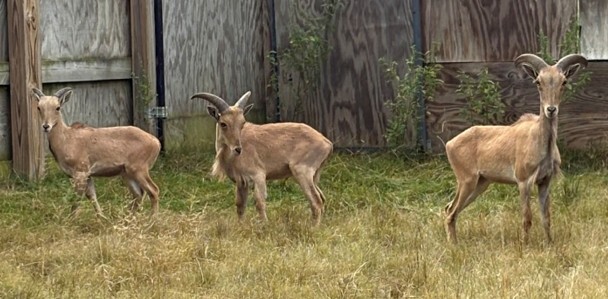Wildwood Zoo Introduces Newest Residents: Three Aoudads
Monday, September 15th, 2025 -- 8:00 AM

Wildwood Zoo is excited to introduce its newest residents, three young female aoudads (also known as Barbary sheep)!
Recently welcomed from a USDA-accredited partner facility, the trio is settling in well and already setting themselves apart with their wary personalities and vigilant energy.
This exciting addition reflects Wildwood Zoo’s dedication to conservation, education, and the care of species that are found in North America. Originally native to the rugged mountains of North Africa, aoudads are a hardy, sure-footed species well-adapted to steep and rocky terrain.
Though not native to North America, they have been introduced in parts of the southwestern U.S., where small populations have become established in wild deserts. Stocky and muscular with sandy coats that help them adapt to rocky surroundings.
Aoudads have a fascinating and complex history. They were introduced to the U.S. in the 20th century to attract sportsmen to Texas for a chance to hunt exotic game. Since then, they have established wild populations where they've become admired for their hardiness.
While they thrive in parts of America, they are nearly extinct in their native range, making their presence in accredited institutions like Wildwood Zoo all the more important.
Aoudads are notable for their striking appearance; their coats are tan to reddish-brown with lighter underbellies, a shaggy mane on their chest and throat, and large, backward-curving horns (both males and females have horns).
Males often have a shaggy mane of hair on their throat, chest, and front legs. They can stand about 2.5–3.5 feet tall at the shoulder and weigh between 100 and 300 pounds.
“Through extensive research and strong collaboration with partner institutions, we've determined that aoudads are better suited to thrive and fight illness at this sea level. We haven’t had the best luck with high-altitude species in the past, but we’re optimistic about the aoudads,” said Kyle Kirk, Curator at Wildwood Zoo.
“These animals are incredibly adaptable, and we’re hopeful they’ll settle in as long-term ambassadors for conservation education.” The zoo’s rock pile exhibit will highlight the aoudads' adaptability, unique biology, and their unexpected ecological journey, from endangered African native to American greenhorn.
The three females (Rainer, Cascade, and Acadia) are currently living behind the scenes while they adjust to their new surroundings. Zookeepers are closely monitoring their acclimation, ensuring they receive the highest quality care, nutrition, and enrichment as they become more confident in their new home.
Wildwood Zoo remains committed to offering engaging wildlife experiences that also educate the public about conservation challenges and successes around the world.
Feel free to contact us with questions and/or comments.




